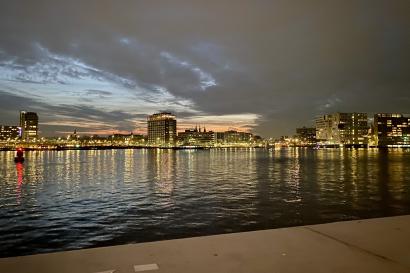
***Due to the inability to access a wireless connection, this post refers to the time around the first week of October***
This past week I was fortunate to have the entire week off from my classes due to the Chinese holiday known as the Golden Week. It is a week-long celebration where most Chinese businesses are closed and many people choose to travel to either their hometowns or vacation destinations. Two friends in my program and I decided to take a trip to the city of Huangshan for part of the week so we could hike the famous Yellow Mountains. After being in Shanghai for about a month, I was ready to see what a different part of China was like.
We decided to leave on the Friday preceding the week, and to return to Shanghai by the following Tuesday. Travelling in China is certainly very different from my previous experiences travelling since there are very different methods of how to travel. It is not common for people to drive from city to city, so people commonly travel by flying, taking a high-speed train or taking a slow train. My group chose to travel from Shanghai to Huangshan by high-speed train. It was fascinating to travel by this method because I had never seen anything like it. The high-speed train shortened what would have been an 8-hour drive into a 3.5 hour ride. The high-speed train, among other things, is an example of how China is leading the world in certain aspects of innovation.
Once we arrived in Huangshan, we quickly found our way to a bus station so we could be taken to the mountain chain. After arriving at the foot of the mountain, we began our ascent to the peak since we were staying in a hostel on top the mountain. With an elevation over 5,000 ft. (and over 6,000 at some of the peaks), this was not an easy hike. We were unlucky on our first day because as we began to climb the mountain, we were surrounded by a thick fog which clouded our views. After hearing so much about the beauty of the Yellow Mountains, I was deeply concerned this fog would persist throughout our trip.
As we made our way up the mountain (with limited visibility), we ran into many other tourists who were at the mountain for the holiday, but surprisingly, there were very few foreigners among the other hikers. This fact was made more apparent as we made it to our hostel that night and realized we were the only foreigners staying there. Since we were on top of a mountain, we were limited in what we could get to eat, but that was to be expected. Roughing it (and the conditions of our hostel truly were rough) was half the fun of the trip! I fully expected to not be staying in a place with the best of conditions, so I wasn’t surprised when our hostel had no showers or mattresses for the wooden bed boards. Though I didn’t sleep much, I now have an interesting story of my travel.
On our second day on the mountain, we set out early to hike the entire loop around the mountain. The loop around the mountain was about a 7-mile distance that included multiple sections of climbing up or down the mountain for extended periods of time. At its lowest point, the loop is just below 3,000 feet of elevation, but at its highest point it reaches about 5,600 feet. The hike was challenging, but the phenomenal views made it hard to focus on the physical exhaustion my body was experiencing. Since we got an early start, we caught glimpses of the sunrise on the mountain which is recommended for every traveler who goes there. The experience was surreal, and despite the many pictures I attempted to take of the sunrise, nothing could truly capture the moment. Though I’ve only been on a few hikes thus far in my life, this hike was by far and away my favorite and has spurred an interest to hike more in the future. The Yellow Mountains are a UNESCO world heritage site, and after visiting it, I can clearly see the cultural value.
My trip to Huangshan and the Yellow Mountains was fascinating because it provided me my first glimpse of rural China. As I saw the first grass-filled countryside I’ve seen in about a month, I was reminded immediately of my home state, Pennsylvania. The wide-open spaces occupied with agricultural fields resembled rural America to me in certain aspects, but the main difference was population density. In rural America, it is common that there are small populations comprising large areas. In China, there is a denser population in these same sized rural areas. Furthermore, the areas I visited were on the fringe of the city of Huangshan, and while many Chinese do not consider Huangshan to be that big of a city, but I certainly did. Though it is hard to compare to the population of Shanghai which is 25 million, a city like Huangshan that is about 1.5 million people is still massive from an American perspective. For example, Huangshan has the same approximate population as Philadelphia, Pennsylvania, which is the sixth largest city in America. In China, Huangshan is about the 80th largest city. This reality reflects the trend of massive urbanization that China is experiencing. Coming from a rural hometown in Pennsylvania, the level of urbanization in China never ceases to amaze me. Details like this, among others, continue to make this study abroad experience one of a kind.

Jason Renner
<p>I love storytelling because of the unique narrative style that each author has, be it through prose or poetry. In a time where understanding each other is of the utmost importance, you can usually learn the most about a person through their work and writing. I value my own distinctive voice, and I hope to share my experiences and convey the knowledge and wisdom I gain from my time abroad through a blog or another platform.</p>







